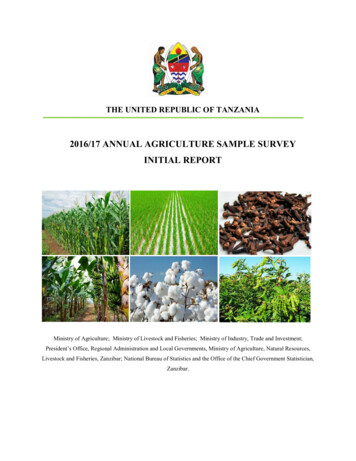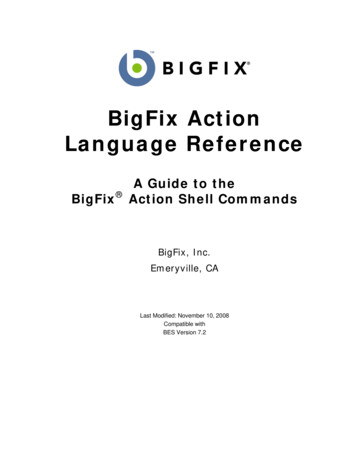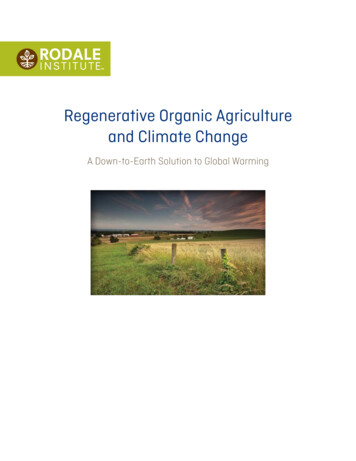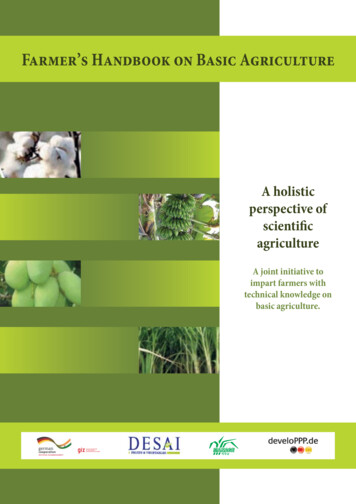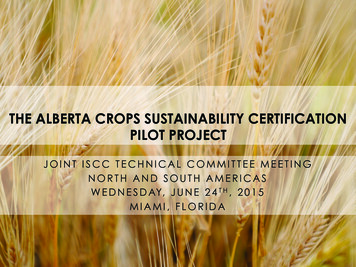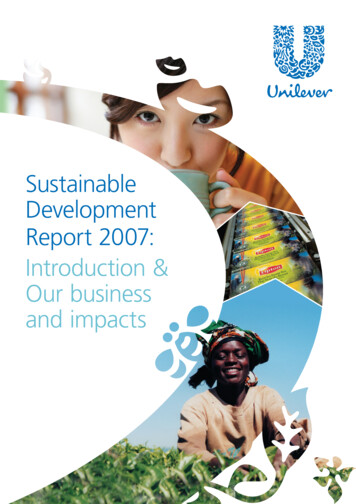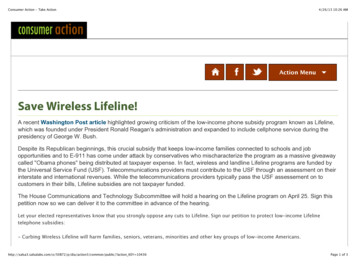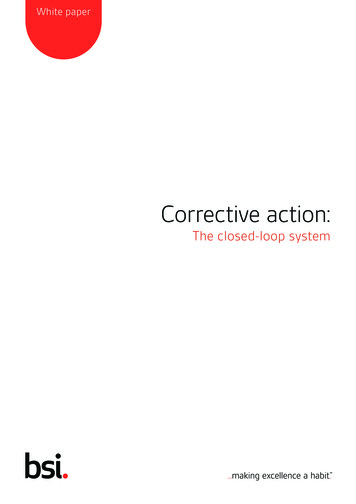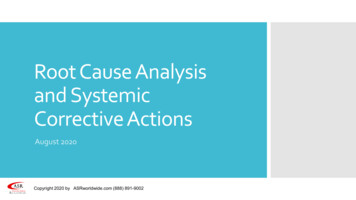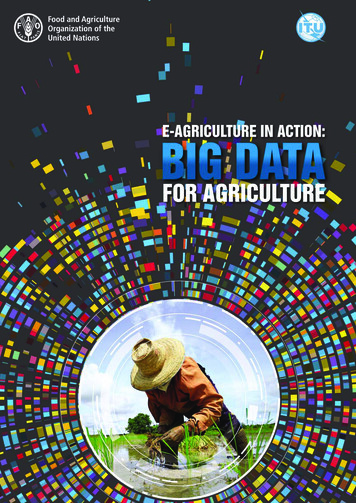
Transcription
E-AGRICULTURE IN ACTION:BIG DATA FOR AGRICULTUREEdited byGerard SylvesterPublished byFood and Agriculture Organization of the United Nationsandthe International Telecommunication UnionBangkok, 2019i
Required citationFAO and ITU. 2019. E-agriculture in Action: Big Data for Agriculture. Bangkok.The designations employed and the presentation of material in this information product do not imply the expressionof any opinion whatsoever on the part of the Food and Agriculture Organization of the United Nations (FAO), or ofthe International Telecommunication Union (ITU) concerning the legal or development status of any country, territory,city or area or of its authorities, or concerning the delimitation of its frontiers or boundaries. The mention of specificcompanies or products of manufacturers, whether or not these have been patented, does not imply that thesehave been endorsed or recommended by FAO, or ITU in preference to others of a similar nature that are notmentioned.The boundaries and names shown and the designations used on this map do not imply the expression of anyopinion whatsoever on the part of FAO concerning the legal status of any country, territory, city or area or of itsauthorities, or concerning the delimitation of its frontiers and boundaries. Dashed lines on maps representapproximate border lines for which there may not yet be full agreement.The views expressed in this information product are those of the author(s) and do not necessarily reflect the viewsor policies of FAO, or ITU.ISBN 978-92-5-131659-7 FAO and ITU, 2019FAO and ITU encourage the use, reproduction and dissemination of material in this information product. Exceptwhere otherwise indicated, material may be copied, downloaded and printed for private study, research and teachingpurposes, or for use in non-commercial products or services, provided that appropriate acknowledgement of FAOand ITU as the source and copyright holders is given and that FAO’s and ITU’s endorsement of users’ views,products or services is not implied in any way.All requests for translation and adaptation rights, and for resale and other commercial use rights should be madevia www.fao.org/contact-us/licence-request or addressed to copyright@fao.org.FAO and ITU information products are available on the FAO website (www.fao.org/publications) and ITU website(http://www.itu.int/en/publications) and can be purchased through publications-sales@fao.org and sales@itu.intCover photo:Cover: Abstract data vector – Adobe Stock/Tartila. Farmer – Shutterstock/Kosin Sukhum.Back cover: Adobe Stock/Lamyaiii
ContentsPreface .vAcknowledgements .viiArticle1: Data driven agriculture: the big data phenomenon .12: Big data: a shift in paradigm towards digital agriculture .113: Unpacking the data driven digital revolution .25Case study1: Big data ecosystem for disaster resilience .372: Olam Farmer Information System (OFIS): improving smallholderproductivity and livelihoods .453: Mobile solutions, technical assistance and research (mSTAR) project .494: Leveraging satellite data and artificial intelligence to drive financialinclusion for smallholder farmers .575: Delivering remote flood analytics as a scalable service .616: AtSource – Connecting customers to the source of supply .697: WAGRI – the agricultural big data platform .73iii
iv Adobe Stock/Chaay tee
PrefaceThe Food and Agriculture Organization of the United Nations (FAO) and the InternationalTelecommunication Union (ITU) continue to work together to promote the use of sustainableinformation and communication technologies (ICTs) for agriculture.FAO and ITU follow a three-pronged approach to assisting member countries in identifying,developing and implementing sustainable ICTs for agriculture. First, through the developmentof the national e-agriculture strategy and related linkages creation; second, is through thesupport to solution implementation together with national partners and third, in promotingknowledge sharing through knowledge products such as the E-agriculture in Action seriesof publication and the bi-yearly E-agriculture Solutions Forum.This publication on big data for agriculture is the fourth in the E-agriculture in Action seriesof publication. With the growth of technology including the impending introduction of 5Gnetworks, which will support a huge sensor network infrastructure, data driven agricultureand the challenges of extracting meaningful insights from various data streams to influencepolicy decision and/or provide actionable advisories for agriculture stakeholders are gainingprominence. This publication tries to shine some light on how various organizations addressthese challenges.The articles in this publication are written by the respective authors and are entirely theirown views. We have tried to maintain the original narrative style of each contributor. NeitherFAO, ITU nor the CGIAR Platform for Big Data in Agriculture promotes or endorses any ofthe statements, comments and products mentioned in the articles. Thus, this is an effort toshare knowledge on the use of successful ICTs for agriculture initiatives and we expect thatthis compilation of case studies will be read in that spirit.v
vi FAO/Gerard Sylvester
AcknowledgementsThis publication is the fourth in the series E-agriculture in Action. This is no mean task andthis is all due to the wonderful support of the authors and their organizations and their valuablecontributions.FAO and ITU are very grateful to CGIAR Platform for Big Data in Agriculture for theirpartnership in bringing out this publication. The importance of sharing knowledge on the useof emerging technologies cannot be overstated.The editor is grateful for the support provided by Kundhavi Kadiresan, Assistant DirectorGeneral and Regional Representative, FAO Regional Office for Asia and the Pacific and IoaneKoroivuki, Regional Director, ITU Regional Office for Asia and the Pacific for their guidanceand support.FAO and ITU extend their special thanks to the authors and their organizations – DharaniBurra (CGIAR Platform for Big Data in Agriculture), Sanjay Srivastava (ESCAP), Zoe Maddison(Olam), Nina Getachew (FHI360) and Kathryn Alexander (Development Gateway), Julie Cheng(Harvesting), Bessie Schwarz and Anindita Chakraborty (Cloud to Street) and Hiroshi Ueharaand Atsushi Shinjo (WAGRI).We thank Iljas Baker for the language editing.vii
viii Tom Fisk from Pexels
Data driven agriculture: the big data phenomenonArticle1Data driven agriculture: the big dataphenomenonAccording to Forbes, we generate almost 2.5 quintillion bytes of data every day (Marr, 2018).With more than half of the world online, as of 2019,1 the amount of data generated is colossal(Figure 1). The increase in the use of Internet of things (IoT) will only add to this data deluge.The Economist magazine rightly called data the world’s most valuable resource (TheEconomist, 2017), and others have called data the new oil (Reid, 2017). From various incidentsin the past, the world has realized the power that an organization or individual wields frombeing able to access valuable data and then monetizing it or, worse, misusing it for personaland political gain.For sustainable development and humanitarian practitioners, big data and new technologieshold great potential to help measure the effectiveness of projects and programmes, andproactively adjust their implementation based on the realities on the ground.UN Global PulseBig data is complex and this brings us to the next big question – how to make sense ofthese huge amounts of data? How do we analyze data patterns to extract actionableintelligence? What data do we store, what do we ignore? It comes as no surprise that datascientists are among the most sought after professionals (Holak, 2019). The demand is drivenby the need to harness valuable insights from data patterns (usually assisted by machinelearning) to influence policy decisions or understand behavioral patterns.How big is big data?One of the most recognized definition is the one coined in 2012 by the Gartner Corporationthat defines big data as “high-volume, high-velocity, and/or high-variety information assetsthat demand cost-effective, innovative forms of information processing that enable enhancedinsight, decision making, and process automation”.2 Big data thus requires not only accessto large data assets, but also the competence and infrastructure to process them in a timelymanner, and the capacity to realize the valuable insights extracted from it (Ali et al., griculture in Action: Big Data for Agriculture1
Data driven agriculture: the big data phenomenonHow much data is generated every minute?There’s no way around it: big data just keeps getting bigger. The numbers are staggering, but they’re notslowing down. By 2020, it’s estimated that for every person on earth, 1.7 MB of data will be created everysecond. In our 6th edition of Data Never Sleeps, we once again take a look at how much data is beingcreated all around us every single minute of the day – and we have a feeling things are just getting started.The world’s internet population is growingsignificantly year-over-year. In 2017, internetusage reached 47% of the worlds populationand now represents 3.8 billion people.3.43.83.02.5201220142016GLOBAL INTERNET POPULATION GROWTH 2012-2017(IN BILLIONS)2017The ability to make data-driven decisions iscrucial to any business. With each click, swipe,share, and like, a world of valuableinformation is created. Domo puts the powerto make those decisions right into the palmof your hand by connecting your data andyour people at any moment, on any device, sothey can make the kind of decisions thatmake an impact.Learn more at domo.comSOURCES: STATISTA, LINKEDIN, INTERNET LIVE STATS, EXPANDED RAMBLINGS, SLASH FILM, RIAA, BUSINESS OFAPPS, INTERNATIONAL TELECOMMUNICATIONS UNION, INTERNATIONAL DATA CORPORATIONSource: re 1: Data never sleeps2E-agriculture in Action: Big Data for Agriculture
Data driven agriculture: the big data phenomenonThe four V’s that characterize the data assets are:Volume: the sheer volume of data available nowadays is enormous and growing. This includesdata generated by people as well as the billions of sensors all over the world that are creatingdata every second and communicating with servers over the Internet, creating what is calledthe Internet of things.Velocity: the speed at which the data are created, stored, processed, analyzed, visualizedand acted upon has increased to up to real time. Big data usually involves collating datagenerated at various speeds and moments and accommodating bursts of activity.Variety: the different kinds of data assets keep increasing. These include structured andunstructured data from databases, devices and sensors, logs, social media, websites andposts, images, email communications, and audio and video streams (such as radio andtelevision), among others.Veracity: the quality (accuracy) of the data and not just the quantity is important and playsa major role in extracting intelligence from big data. The trustworthiness of the data sourceand processes to “clean up” data by removing abnormalities and inconsistencies are importantto improve the accuracy of data.Many organizations and individuals also extend the definition to include:Volatility: is the rate of change and lifetime of the data. This also determines the storageperiod of the data.Validity: As with veracity, validity ensures that the stream of data is correct and accurate forthe intended use at the desired time.Visualization: A picture speaks a thousand words, thus the desirability of using graphs andinfographics to convey information from complex data patterns.Value: Getting value from the data is the key objective of big data analysis. How do youtransform mountains of data to actionable insights to support your decision-making?The context of the content is very important. Combining data from multiple data streamsand devices should be based on a definitive understanding of the context of the data. Theintroduction of 5G networks brings in a huge potential to support massive sensor networks,enhanced broadband access together with ultra-high reliable low latency mobile networks.These developments are bound to generate huge amounts of data starting from smart cities,smart transport networks to agriculture and personal wearables, creating the Internet of things(Figure 2). Investment in developing efficient processes and infrastructure is needed to supportthese technologies and ensure the efficacy of the data generated.Data harmonization is crucial as data can be structured and unstructured in huge volumesand may be collected from heterogeneous sources. After data harmonization, the time andenergy required to run analytics and extract insights from big data greatly reduces.Standardization of big data technologies would also facilitate ease of interoperability, andE-agriculture in Action: Big Data for Agriculture3
Data driven agriculture: the big data phenomenonOne to many to any: ICTs from happy few to the massesArtificialintelligenceMainframe (1 computer, many people)PC (1 person, 1 computer)Digital native computing (1 person, many screens)Internet of everythingVolumes, BMobile broadband,smartphones, tabletsMass wearablesCognitivecomputingSocial MediaConnected carInternet bornInternet of ource: International Telecommunication UnionFigure 2: Growth of connected networkswould facilitate generating newer insights by combining or correlating two different data sets.The International Telecommunication Union is working with partners to standardize big datarelated activities.3With big data comes big challengesData privacyData privacy, related security and other aspects of handling data are of paramount importanceand the regulations related to data privacy in each geographical area have to be taken intoconsideration. The European Union General Data Protection Regulation (GDPR)4 outlinesregulations and the European Union law on data protection and privacy for all individualswithin the European Union and the European Economic Area. The Association of SoutheastAsian Nations (ASEAN) framework for personal data protection provides some guidelines ondata protection for ASEAN member countries.5 A report6 from Deloitte highlights thesignificance for business of data and privacy protection in ASEAN countries. In particular, itmentions that globalization and digitalization have become a double-edged sword asbusinesses attempt to comply with data protection regulations in a borderless Internet world.Not long ago, the places where data were generated processed, analyzed, stored, and usedwere not necessarily on the same continent. This is fast changing now with many cy-in-asean.pdfE-agriculture in Action: Big Data for Agriculture
Data driven agriculture: the big data phenomenonhaving invested in developing frameworks and laws governing the collection, processing andstorage of personal data. The economy of monetizing private data, without explicit permission,is being seriously suppressed. The United Nations Development Group (UNDG) has sets outgeneral guidance on data privacy, data protection and data ethics on big data for achievementof the 2030 agenda7.While discussing the power and the value of data, it is imperative to discuss the key aspectof how to handle data privacy too. Almost all countries have put forward very clear guidelines,policies or fundamental principles to protect personal data. DLA Piper, a global law firm, hasproduced an excellent compilation of the various data protection laws around the world8 (seeFigure 3). Their handbook for data protection laws of the world,9 documents the dataprotection laws, guidelines or framework in more than a 100 countries worldwide.Figure 3: Data protection laws around the worldThe General Data Protection Regulation10 of the European Union outlines very strict regulationson what organizations can do with individual data sets as well as extends the rights ofindividuals to control how data about them are used. The GDPR proposes the following sixdata processing/protection principles:1. Lawfulness, fairness and transparency: This emphasizes that the organization’s dataprocessing laws are in line with GDPR’s requirements and that organizations havea valid reason to collect the data and the data subjects are well aware of the purposeof collecting and processing their data.2. Purpose limitation: This extends the first principle to limiting the use (collecting,processing and storage) of the personal data for the specific purpose for which it 2017/11/UNDG BigData final tps://gdpr-info.eu/8E-agriculture in Action: Big Data for Agriculture5
Data driven agriculture: the big data phenomenon3. Data minimization: This clearly states that organizations should collect only thenecessary information (adequate, relevant and limited) that is needed to achieve itsprocessing objectives.4. Accuracy: This leads from the principle of data minimization and emphasizes that thepersonal data collected are kept up to date and adequate steps are taken to ensurethe correctness of the data. Data that is not accurate or relevant should be deleted.5. Storage limitation: This stipulates that the personal data must be kept for no longerthan is necessary. Data that is no longer required should be deleted because if not, itwould conflict with the accuracy principle.6. Integrity and confidentiality: This stipulates protection for personal data in terms ofsecurity and confidentiality (against unlawful processing, loss, damage, etc.) usingappropriate technical and organizational measures.These principles coupled with the rights that individuals have to access and control theirdata makes GDPR one of the most powerful privacy laws today.Infrastructure and digital securityInfrastructure and digital security is also a major concern. Countries such as India, with theAadhaar,11 Gambia with GAMBIS,12 and the European Union with the proposal to create theCommon Identity Repository (CIR) are embarking on creating and maintaining a megabiometrics database of citizens (Cimpanu, 2019). Such a repository is tantalizing for hackersand the huge treasure trove of data would always be a tempting target. Major governmentdatabases being hacked are regular news. In 2015, hackers stole some 5.6 million fingerprintsfrom data networks belonging to the government of the United States of America (BBC, 2015).In 2018, a security vulnerability in India’s Aadhaar left many people at risk of identity theft(Doshi, 2018). Big data infrastructures are also prone to such vulnerabilities and data breaches;hence, information and infrastructure security should be one of the key components of bigdata infrastructure management.Good data versus big dataMore data is not always better. In many instances, collecting a selected set of data streamsregularly provides more value than aimlessly gathering a broad set of data. Hence, when wetalk of big data, we also need to emphasize the need for good data. If analytics were to bebuilt on data that are not reliable or continuous then we would fall into the garbage-in-garbageout scenario. Analytics plays a key role in realizing the value of the collected data. If effectiveand efficient algorithms are not designed to separate out actionable intelligence then we arelikely to find ourselves drowning in data but thirsting for gm/E-agriculture in Action: Big Data for Agriculture
Data driven agriculture: the big data phenomenonCollecting, storing and organizing dataCollecting quality data forms the basic building blocks of data driven agriculture. Initiativessuch as the global strategy to improve agricultural and rural statistics13 help address thedeclining quantity and quality of agricultural statistics. Open source kits such asKoboToolbox14 provide simple, robust and powerful tools for data collection. The ComputerAssisted Personal Interview (CAPI)15 technology assists governments, statistical offices andnon-governmental organizations in conducting complex surveys with dynamic structures usingtablet devices. The development of CAPI is co-financed by the World Bank, the Bill andMelinda Gates Foundation and the Food and Agriculture Organization of the United Nations.The Open Data Kit16 community produces free and open-source software for collecting,managing, and using data in resource-constrained environments.As for storage, in most instances cloud-based storage of big data would be the natural choiceas this would facilitate cloud computing and a huge reduction in the cost of operations.Algorithms such as MapReduce are used for processing and generating big data sets witha parallel, distributed computing facility thereby allowing massive scalability. A Hadoop clusteris one example of a computational cluster working in a distributed computing environmentthat is used to store, analyze and work on huge amounts of unstructured data.Tools for data analysis, modeling and visualizationTo run an optimal analysis and extract insights, it is important that the data is cleaned, sortedand stored in the right way. The majority of a data professional’s time should be spent inpreparing the data to be in the best shape to facilitate running analytics.Many tools and platforms are available to prepare the data, transforming and modeling it tofacilitate extracting insights. Solutions such as Knime17 provide an open solution for datadriven innovation. OpenRefine18 is a helpful tool to work with unstructured data and it canhelp users explore large data sets with ease. The R-Project19 supports data mining as wellas provides statistical and graphical techniques, including linear and nonlinear modeling,classical statistical tests, time-series analysis, classification, clustering, and others. Orange20allows open-source machine learning and data visualization.Data visualization helps in conveying insights generated from big data effectively. Forvisualization, Power Bi21 from Microsoft provides interactive visualization and businessanalytics. Tableau22 provides an analytics platform to extract insights by facilitating the flowof analysis from data preparation, analytics and collaboration. Infogram23 helps in creatingengaging infographics and reports to help visualize -agriculture in Action: Big Data for Agriculture7
Data driven agriculture: the big data phenomenonWay forwardAgriculture is increasingly knowledge-intensive. Knowledge derived from combining data fromvarious sources can be used to derive valuable actionable insights. At the farm-level, thefarmers of today have to deal with a myriad of data to be able to make livelihood-baseddecisions on a regular basis. Data on soil health, weather, irrigation, markets, early-warningsystems, diseases and pests, finance/loan availability, as well as government-relatedinformation/subsidies all come into play in making a decision at the farm-level. At the provinceor district level, the policymaker has to have real-time or near real-time information on marketprices, projected yield of a particular crop at the end of the harvest season, beneficiaries ofgovernment schemes/subsidies, efficacy of pre-emptive actions to protect against diseasesand pests, disaster mitigation and much more. At the national level, quality data would helpdesign effective policies to assist smallholder farmers, monitor and remove inefficiencies inthe value-chains, ensure consumers about quality produce and to eradicate hunger,malnutrition and ensure food security in the country. At the global level, a coalition includingFAO, the Bill and Melinda Gates Foundation and national governments has launcheda USD 500 million effort to help developing countries gather data on small-scale farmers tohelp fight hunger and promote rural development (Tollefson, 2018). Agriculture, as other fields,will have the unprecedented capability to extract intelligence and make evidence-baseddecisions firmly grounded on real-time, reliable data and effective analytics. Introduction ofnew actors in the value chain and investment in developing the capacities of existing actorswill be some of the key challenges that governments will have to address. Newer ways ofharvesting data will lead to granular insights that previously was impossible to achieve. TheUN Global Pulse recently explored using data from social media and public broadcasters toextract insights to feed early warning systems and to inform peace and security processesin Africa (Hidalgo-Sanchis, 2018).We should not miss the opportunity to harness actionable intelligence from big data to achievethe Sustainable Development Goals. The cost of inaction would be far greater if we do notput in place an organizational data ecosystem to utilize the wealth of data that we have andto derive valuable insights from it.8E-agriculture in Action: Big Data for Agriculture
Data driven agriculture: the big data phenomenonReferencesAli, A., Qadir, J., Rasool, R., Sathiaseelan, A., Zwitter, A. & Crowcroft, J. 2016. Big data for development: applicationsand techniques, Big Data Analytics 1: 2. (Also available at https://doi.org/10.1186/s41044-016-0002-4).BBC. 24 September 2015. Millions of fingerprints stolen in US government hack [online]. [Cited 15 February 02Cimpanu, C. 22 April 2019. EU votes to create giant biometrics database [online]. [Cited 28 April 2019]. igantic-biometrics-database/DLAPiper. 2014. Data protection laws of the world handbook: third edition [online]. [Cited 14 February i, V. 2018. A security breach in India has left a billion people at the risk of identity theft. Washington Post4 January 2018 (also available at llion-people-at-risk-of-identity-theft/?utm term .fc94931e4afc).Economist. 2017. The world’s most valuable resource is not oil, but data. Print edition 6 May 2017 (also availableat ata).Hidalgo-Sanchis, P. 2018. Using big data to support peace and security efforts in Africa. United Nations GlobalPulse. Blog 26 December 2018 [online]. [Cited 14 February 2019]. ak, B. 2019. Demand for data scientists is booming and will only increase. TechTarget. Search Business Analytics31 January 2019 [online]. [Cited 22 March 2019]. l-increaseMarr, B. 2018. How much data do we create every day? The mind-blowing stats everyone should read. Forbes21 May 2018 [online]. [Cited 24 February 2019]. wing-stats-everyone-should-read/#7e1ce72e60baReid, D. 2017. Mastercard’s boss just told a Saudi audience that ‘data is the new oil’ CNBC News 20 October2017 [online]. [Cited 2 March 2019]. st-said-data-isthe-new-oil.htmlTollefson, 2018. Big data project aims to transform farming in world’s poorest countries. News. Nature: InternationalJournal of Science 24 September 2018 [online]. [Cited 4 February 2019]. AuthorGerard SylvesterGerard.Sylvester@fao.orgFood and Agriculture Organization of the United NationsE-agriculture in Action: Big Data for Agriculture9
Data driven agriculture: the big data phenomenonNO POVERTYSpending patterns onmobile phone servicescan provide proxyindicators of incomelevelsCLEAN WATERANDSANITATIONSensors connectedto water pumpscan track accessto clean waterZERO HUNGERCrowdsourcing ortracking of food priceslisted online can helpmonitor food securityin near real-timeAFFORDABLEAND CLEANENERGYSmart metering allowsutility companies toincrease or restrictthe flow of electricity,gas or water to reducewaste and ensureadequate supply atpeak periods12GOOD HEALTHAND WELL-BEINGMapping the movementof mobile phone userscan help predict thespread of in
E-agriculture in Action: Big Data for Agriculture 1 Data driven agriculture: the big data phenomenon Data driven agriculture: the big data phenomenon Article 1 According to Forbes, we generate almost 2.5 quintillion bytes of data every day (Marr, 2018). With more than half of the world online, as of 20

